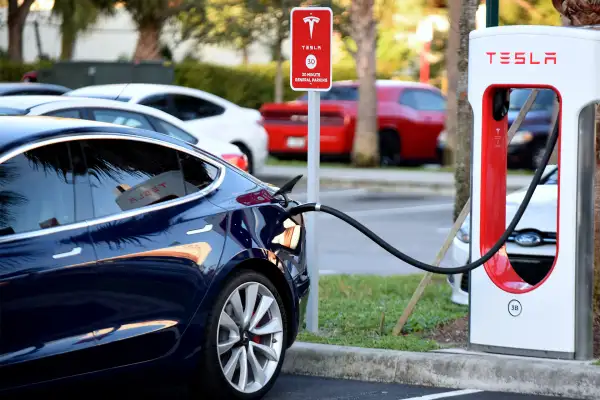Tesla Stock Has Nearly Quintupled in 2020. Is the Bubble About to Burst?
Money is not a client of any investment adviser featured on this page. The information provided on this page is for educational purposes only and is not intended as investment advice. Money does not offer advisory services.

Say “bubble” these days, and you might think of the NBA playoffs, with isolated basketball players staying safe in a global pandemic.
But in stock-market terms, bubbles refer to companies or sectors or asset classes that just keep on inflating – to the point where the dreaded ‘pop’ might bring it all to an end.
Any company with a meteoric rise is drawn into a bubble debate: Is the share price justified, or has it become detached from reality? In 2020, one of those breakout firms is electric carmaker Tesla.
Elon Musk’s baby has had a nearly five-fold increase in 2020, vaulting him past Facebook’s Mark Zuckerberg to become the world’s third-richest person, behind only Jeff Bezos and Bill Gates. Its market cap briefly soared over $400 billion, making it by far the world’s most valuable automaker. (The stock was down about 7% on Thursday amid a market-wide selloff).
So is this a bubble we’re witnessing, or not? “Not yet, but it’s getting there,” says Joe Osha, equity research analyst for JMP Securities, who currently has a “Market Perform” rating on the stock. “If you think this company can generate $100 billion in sales in a couple of years, then it’s probably worth $400 billion. That’s not insane.”
But perhaps it’s time for investors to take a breath, especially since Tesla itself just announced plans for a share sale of up to $5 billion in a recent SEC filing. The selloff is to “strengthen our balance sheet, as well as for general corporate purposes,” the company disclosed.
In personal-finance terms, it’s a smart move for Tesla. With the share price so lofty – although the recent 5-for-1 split has tweaked the math – Tesla can raise a ton of cash to clear debt, expand capacity, or invest in R&D, while only giving up around 1% of the company. If “selling high” is always the goal, the firm is doing exactly that by taking some chips off the table.
In fact, JMP’s Osha thinks they should do even more. “It ought to be $20 billion,” he says. “They should take advantage of this extraordinary market cap to position themselves for the future. They could put so much money on their balance sheet that they become almost unbeatable.”
As a new retail investor, though, the move might give you pause. It’s essentially the opposite of a stock buyback, in which firms demonstrate confidence in their own prospects by snapping up their own shares.
Indeed, you have to wonder about further upside potential for Tesla after such an amazing run. Many analysts are concerned that the price has floated away from balance-sheet fundamentals: Goldman Sachs has stuck to its “neutral” rating and target of $295, suggesting that a further price drop could be in the offing.
Is Tesla a really a tech, energy or auto company?
Of course, the tricky part is how to value such a disruptive company. Is it an automaker, that should be valued against its peers in that space? Is it a next-generation energy company? Or a technology concern, that should be properly compared to Big Tech valuations? Or, perhaps most accurately, a unique blend of all of those elements?
The challenging thing about bubbles is that they are typically identified in retrospect. When you are in the middle of it, visibility isn’t as clear. Amazon, for instance, has been accused of bubble-like valuations many times over the course of its existence, and yet powers to new highs as the “Everything Store” keeps taking over global retail – including a 90% rise in 2020 alone.
For help in identifying what is a bubble and what isn’t, we turned to one of the foremost experts on the subject: William Quinn, a lecturer at Queen’s University Belfast and co-author of “Boom and Bust: A Global History of Financial Bubbles”.
“It's uncontroversial to say that Tesla's share price is very high by traditional metrics,” he says. “The company has an exciting and compelling narrative associated with it, and tends to attract shareholders who haven't invested before, both of which are common features of a bubble.
“The fact that its share price has continued to rise for several years, despite the skepticism of most professional investors, feeds the narrative that it's a fundamentally unique company to which the old investment rules don't apply. Again, this is a recurring feature in historical bubbles.”
The recent stock split may play into that dynamic, making it more affordable to mom-and-pop investors who love Elon Musk’s seemingly magic touch. Throw in other positive trends -- like a pandemic-inspired market tilt towards technology, and potential inclusion in the S&P 500, which would necessitate a large round of buying from index funds – and you have plenty of tailwinds pushing the company forward.
Just remember that if you do decide to invest in coming months, it could be the company itself on the other side of that trade.
“It builds the best electric cars, and not by a little,” says Osha. “So it should continue to prove to be a good long-term investment. But I suspect that at some point, you should be able to buy it cheaper.”
More from MONEY:
Apple and Tesla Are Taking Off (Again) After Stock Splits
High-Yield Savings Rates Have Tanked, but These Overlooked Accounts Still Pay 2% or More
Congratulations! You Won Big Betting on Tech Stocks. Now Start Selling Them
